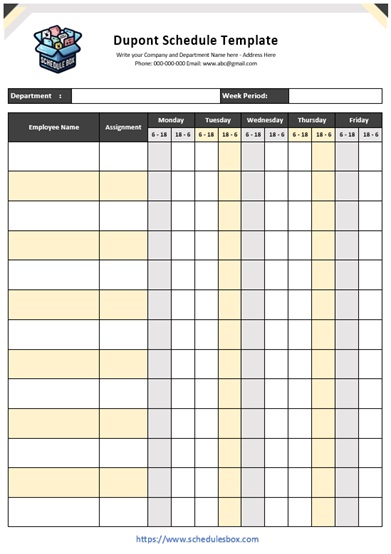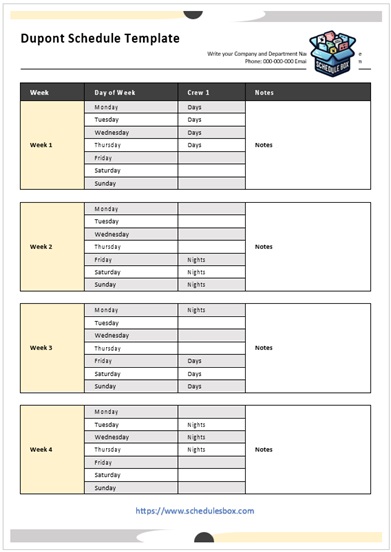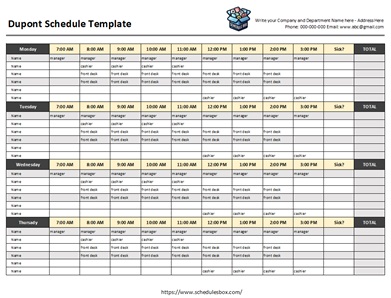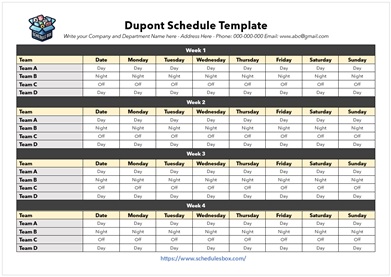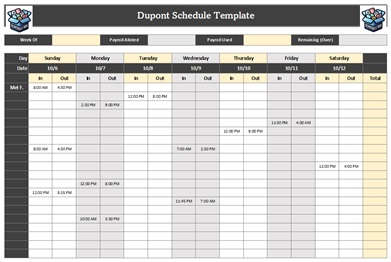Download these Free DuPont Schedule Templates in MS Word and MS Excel format to help you prepare our own DuPont Schedule quickly.
The DuPont Schedule is a type of 12-hour rotating shift pattern used by businesses that require 24/7 coverage. This schedule, developed by the DuPont company, is structured to provide coverage all day and night by using four teams who rotate shifts, covering both day and night shifts over a set period, typically 28 days. Here’s how it generally works:
- Shift Length: Each shift is 12 hours long.
- Rotation: Employees typically work a series of three or four consecutive shifts, then have several days off.
- Pattern: It is the standard working procedure where the workers change their shifts from working at night to working during the day in the same week, a thing that may not be easy when it comes to making sure that you keep on getting uninterrupted beauty rest.
- Coverage: This system setup is designed to ensure that the operation can go on without interruption.
Complex operations can be staffed easily by use of DuPont Schedule but also calls for proper management as workers should have enough time to rest due to long shifts with fast day and night rotation.
Free Dupont Schedule Templates
Here is a collection of Free Dupont Schedule Templates that I have created to assist you in this process.
The implementation of the DuPont Schedule varies to some extent depending on the specific needs of the organization, but there are some standard kinds that are commonly adopted by most businesses. These are different versions meant to help distribute the workload evenly and allow for some rest time that is vital for continuous functioning. Here are three typical types of DuPont Schedules:
- Classic DuPont:
- Duration: 4-week cycle
- Shift Pattern: Workers usually have a pattern of following, first working four-night shifts, then taking three days off or three-day shifts, and finally one day off, after which they return to work by putting in three-night shifts followed by another three days off before embarking on four-day shifts culminated by seven consecutive days off.
- Features: The long break (seven days of rest) before the next morning or overnight work shifts makes this itinerary notable mainly because it allows significant time for relaxation and recuperation.
- Modified DuPont:
- Duration: Varies, often a 4-week cycle
- Shift Pattern: In comparison with the standard DuPont’s schedule, there are likely to be some changes in the sequence and timing of off days and shifts. This may lead to a reduction in the number of days having night shifts one after the other, or could involve modification of the duration of pause that suits particular working requirements better or that workers prefer most.
- Features: The modified version wants to solve some problems from the old DuPont schedule like fewer hours between day and night shifts and its total duration.
- DuPont with Extended Breaks:
- Duration: 4-week cycle or longer
- Shift Pattern: It is more like the old DuPont, only that it has extra days off between working days such as two stretches of four days or some long break at the middle of the cycle.
- Features: Tiredness and happiness can be reduced by having more rest time provided for in these timetables, it also helps in making the worker feel better as suggested by their design.
All DuPont Schedules have their pros and cons. In choosing a specific schedule, few things are more important than health, safety, compliance with regulatory norms, efficiency in operations, and others. These are the reasons behind many managers’ use of individualized project timelines that curb job frustrations that workers encounter in their daily activities while at the same time ensuring that different organizations attain their wildest dreams of productivity.
Benefits of using ready-made Dupont Schedule Templates
When it comes to organizing challenging shift systems, choosing one of the already prepared DuPont Schedule templates is always beneficial for any firm in charge of their management. Here are some of the main advantages:
- Time Savings: Pre-generated templates help a lot in savesaving of time as far as planning or planning and scheduling is concerned. There is no need for administrators to create new schedules because they do not have any obligation to build it. Instead, it allows them to concentrate on other parts of their duties.
- Accuracy and Consistency: The organization is supported by templates in have the same correct schedules. This is important as it assists in promoting equity and openness in the organization among the employees as well as preventing any possible scheduling clashes.
- Ease of Use: Usually, templates are designed with a user in mind so that they can be easily customized. This makes it easy for both new and experienced schedulers to manage complicated shift patterns.
- Compliance Assurance: Many templates are designed keeping in mind regulatory compliance so that the timing of work and rest can meet the legal requirements as per the law. It’s more crucial in sectors where there are stringent laws governing working hours and hours of labor.
- Improved Planning: The availability of ready templates aids in the anticipation of future staff requirements. It helps the managers see when there is likely to be too many workers or too few workers if action is not taken beforehand.
- Reduction of Human Error: Human errors can easily occur through manual scheduling, like double-booking shifts or failing to give breaks properly, but these errors can be reduced by the use of templates with which schedulers can adhere.
- Better Staff Morale and Retention: Staff morale and retention can improve with consistent and fair schedules. When schedules are predictable and administered fairly, employees tend to be more satisfied with their work/life balance.
- Optimization of Resources: Employees in businesses are used more economically by having effective timetables which in turn cut employee compensation costs when workforce presence aligns with requirements but no extra staff or few staff members are hired.
Organizations can streamline their scheduling processes, reduce administrative burdens, and focus more on operational efficiency and employee well-being by using pre-created Dupont Schedule templates.


